| Columns Retired Columns & Blogs |
Can anyone say when this unit does PCM (redbook) is it using DS (1bit) type or Multibit converter, as that looks to be over looked in the review.
Cheers George
I measured the T+A DAC 8 DSD with my Audio Precision SYS2722 system (see the January 2008 "As We See It"). Sources were either digital signals fed via AES/EBU or TosLink from the SYS2722, or WAV and AIFF test-tone files played with Pure Music 3.0 on my MacBook Pro running on battery power and fed via USB. Apple's USB Prober utility identified the processor as the "DAC 8 DSD HD-AUDIO" from "T+A ELEKTROAKUSTIK," and confirmed that the T+A's USB input operated in the optimal isochronous asynchronous mode. The AES/EBU and S/PDIF inputs accepted data sampled at up to 192kHz. Apple's AudioMIDI app indicated that the T+A DAC operated at all PCM sample rates from 32 to 384kHz via USB, with bit depths of up to 32. The DAC 8 successfully decoded DSD64 and DSD128 data fed it via USB from the MacBook. I left the Clean/Wide switch in the Wide position for all the measurements.
The T+A's volume control operates in steps of 1.25dB. The maximum levels with 44.1kHz data were 4.36V from the balanced output, 2.175V from the unbalanced output, and 6V from the headphone output, all with correct absolute polarity. The balanced output impedance at 20Hz was higher than the specified 44 ohms but still low at 114 ohms, dropping slightly to 104 ohms at higher frequencies; the unbalanced impedance was 53 ohms at 20Hz, 48 ohms at 1kHz, and 46 ohms at 20kHz; the headphone output impedance was 23 ohms at all audio frequencies, which is a bit higher than is optimal for driving low-impedance 'phones. (The DAC 8's manual doesn't recommend using it with headphones of less than 30 ohms impedance.)
Measuring the DAC 8 with PCM data was complicated by the fact that there are four options of digital reconstruction filter, displayed on the front panel as "FIR1," "FIR2," "Bez1," and "Bez2." Figs. 1–4 show the impulse response of each filter with 44.1kHz data. FIR1/Filter 1 (Standard FIR, fig.1) is typical of a conventional Finite Impulse Response filter, with symmetrical ringing to either side of the single 0dBFS example; FIR2/Filter 2 (the Impulse Optimized filter, fig.2) is similar, but with fewer coefficients; Bez1/Filter 3 (the Bézier Interpolator plus IIR, fig.3) is a very short asymmetrical filter similar to that used by Ayre Acoustics in its QB-9
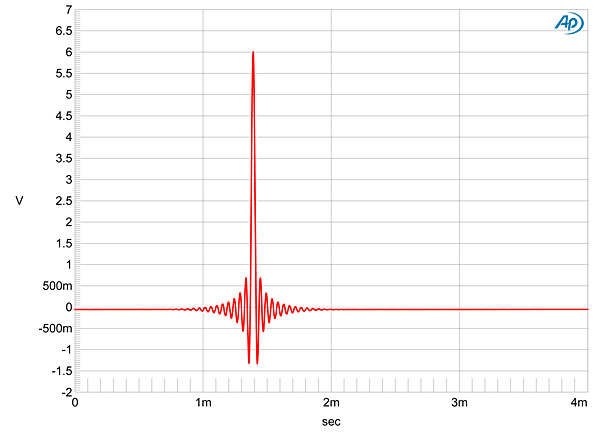
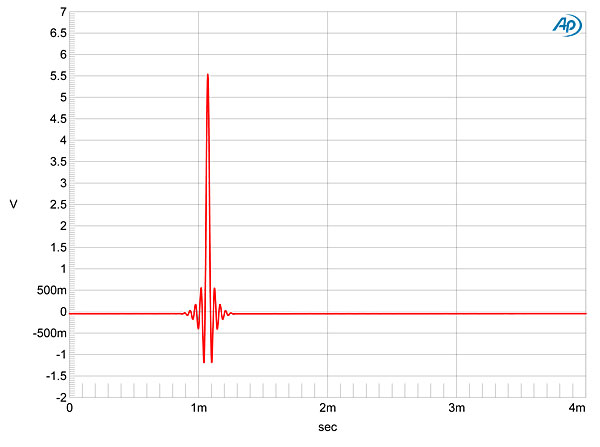
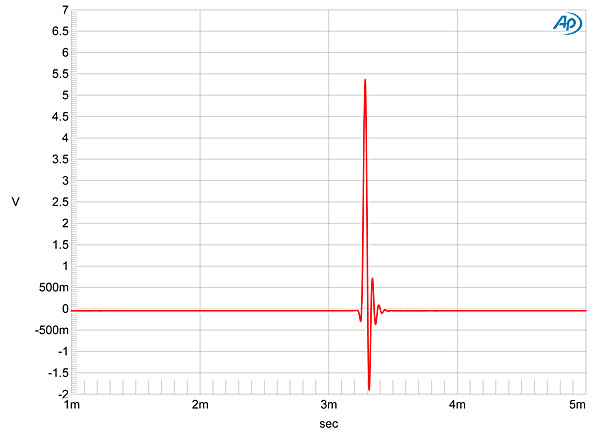
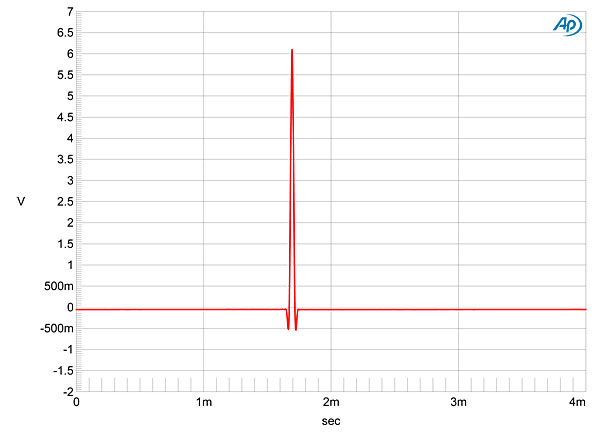
Figs.5–8 show the frequency-domain behavior of the four filters with the DAC 8 fed 24/44.1 PCM data representing a 19.1kHz tone at 0dBFS and white noise at –4dBFS (footnote 2). FIR1 (fig.5) features a very sharp rolloff above the audioband, with the level of the image at 25kHz of the 19.1kHz tone suppressed by almost 90dB. Though the second and fourth harmonics of the tone can be seen, they are very low in level. By contrast, FIR2 (fig.6) features a very slow ultrasonic rolloff, with the 25kHz image suppressed by just 15dB and a large number of aliasing components present in the audioband. With this filter, the DAC 8 offers similar behavior to the "NOS" DACs whose sound some audiophiles adore. Bez1 (fig.7) offers a slow rolloff and poor image suppression similar to those of FIR2, but without the audioband aliasing. Bez2 (fig.8) offers a slower rolloff starting at 10kHz, with a sharply defined null at the sample rate.
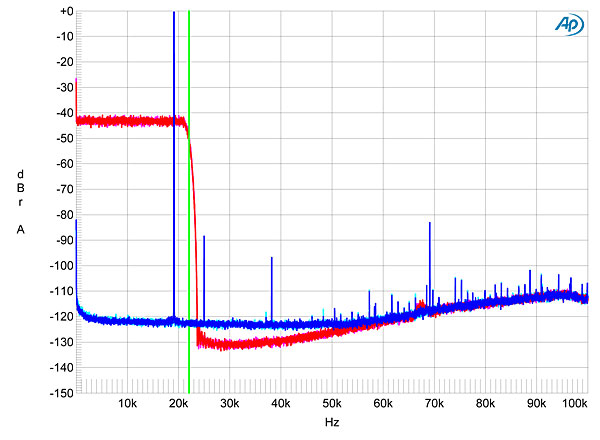
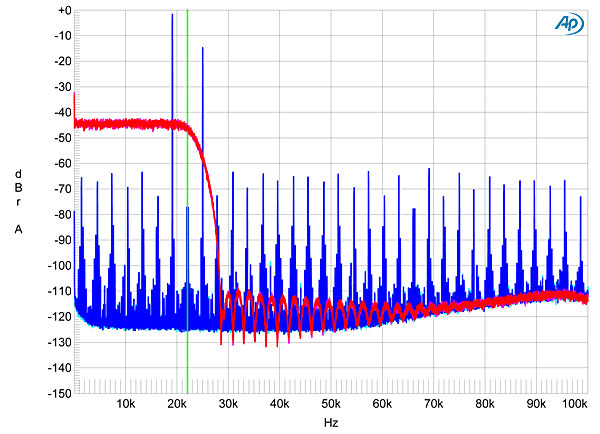
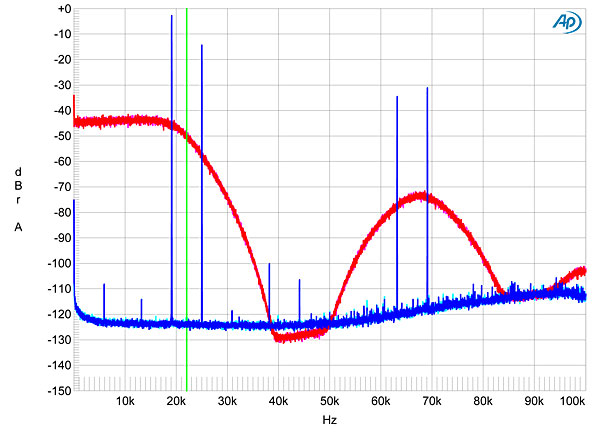
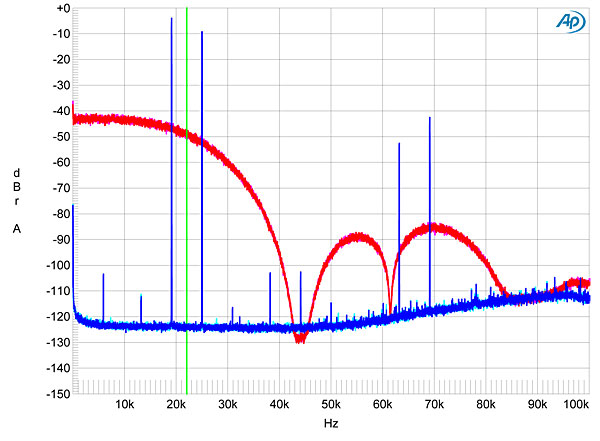
I haven't shown the frequency responses with FIR1 and FIR2, which are flat almost to the Nyquist frequency (half of each sample rate). But Bez1 and Bez2 offered some anomalous behavior. Fig.9 shows the response with PCM data sampled at 44.1, 96, and 192kHz and with the responses normalized to eliminate the level difference noted above. Some peaking is evident in the top two audio octaves at the two lower rates before the expected rolloff. Only at 192kHz does the ultrasonic content roll off as expected, though this occurs somewhat below the 96kHz Nyquist frequency. With data at 384kHz (not shown) the output is down by 2.5dB at 100kHz, and by 10dB at 168kHz. No peaking is evident with the Bez2 filter (fig.10), but the earlier rolloff is evident at all three rates, with the output at 20kHz down by almost 3dB with 44.1kHz data (green and gray traces).
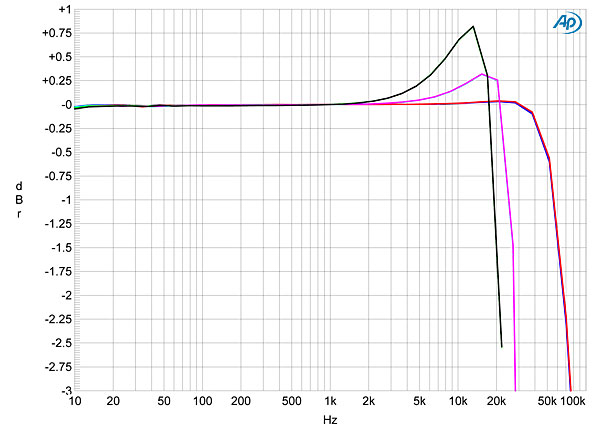
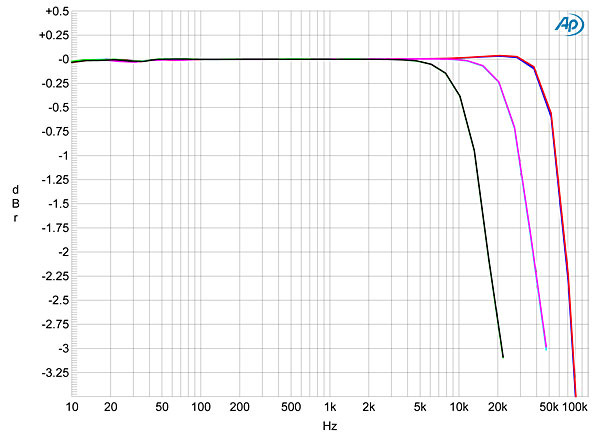
The DAC 8's noise floor was free from any power-supply–related spuriae (fig.11), and channel separation was superb, at >125dB below 1kHz and still 113dB at 20kHz. Increasing the bit depth from 16 to 24 with a dithered 1kHz tone at –90dBS dropped the noise floor by >20dB, which implies resolution of almost 20 bits (fig.12). This is superb resolution, and was not affected by the choice of filter. One puzzle: This graph was taken with AES/EBU data, and the 24-bit tone is accompanied by odd-order harmonics. These harmonics were absent when I repeated the test with USB data (fig.13), which makes me wonder if, with AES/EBU data, the 24th bit was being truncated. Nevertheless, with undithered 16-bit data at precisely –90.31dBFS, the waveform was accurately reproduced (fig.14), with symmetry, three clearly defined DC voltage levels, and negligible DC offset. With undithered 24-bit data, the result was a good sinewave (fig.15).
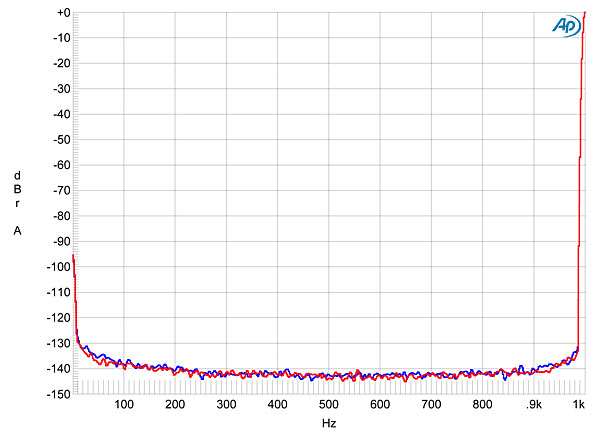
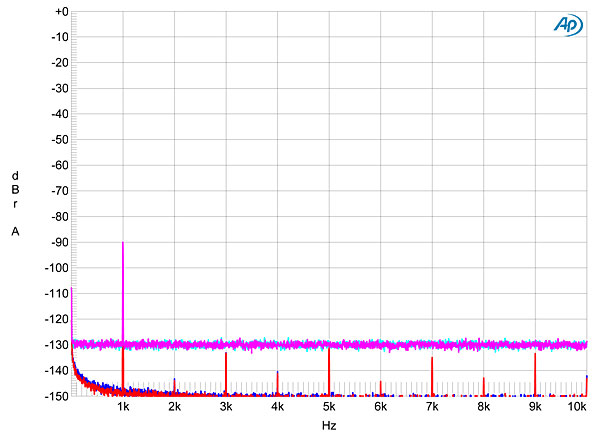
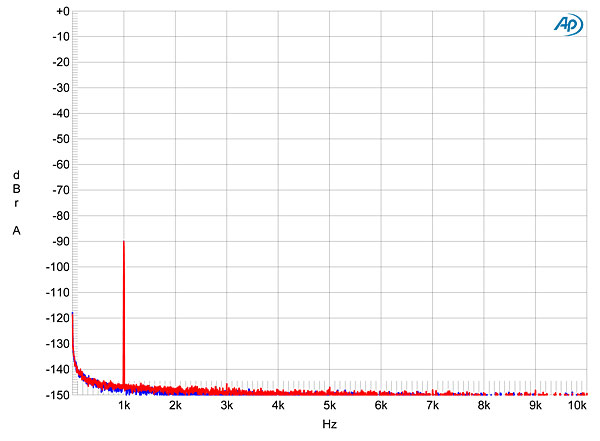
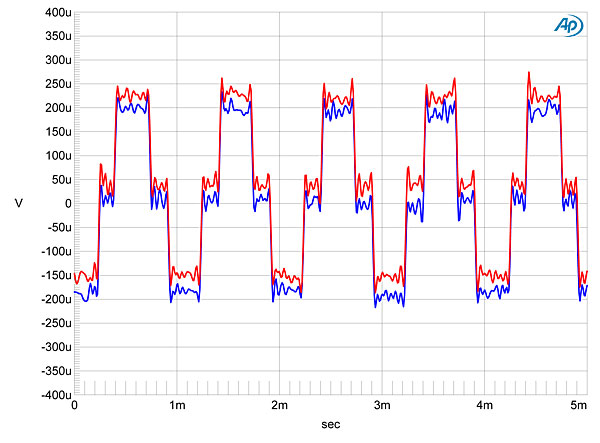
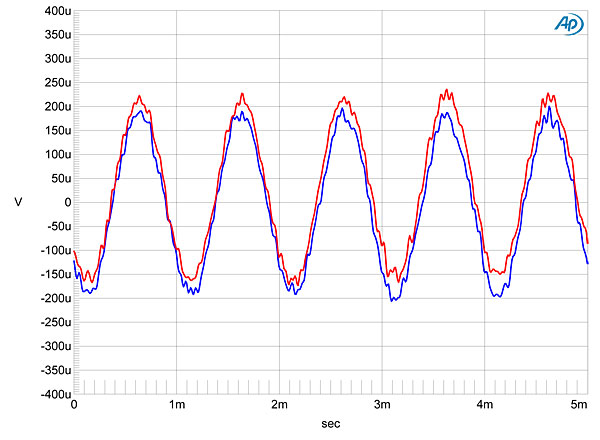
Into high impedances, the DAC 8 DSD offered low levels of distortion. Fig.16 was taken with the balanced output driving a full-scale 50Hz tone into 100k ohms. The second harmonic is the highest in level, at –100dB (0.001%), and although some higher-order harmonics can be seen, these are even lower in level. The T+A's line outputs were less happy with the punishing 600 ohm load; the level of the tone had to be reduced by 3dB to bring distortion down to an acceptably low level. The headphone output had no problem with low impedances; at full volume into 33 ohms, the third harmonic was the highest in level, at –90dB (0.003%, fig.17).
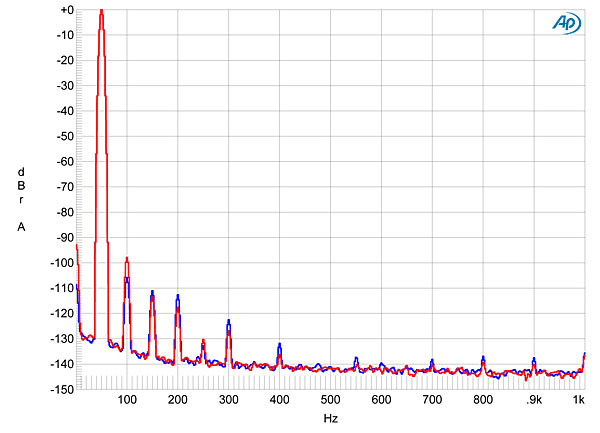
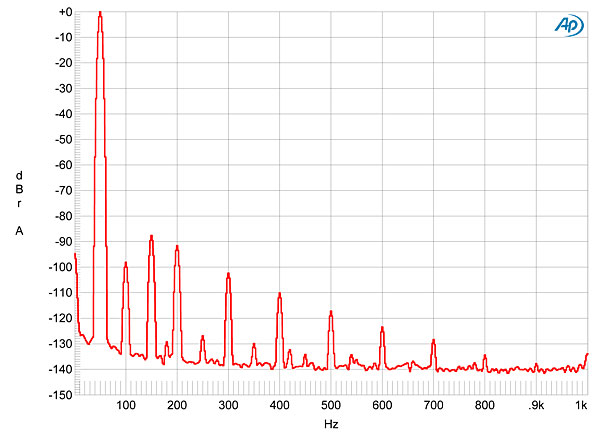
Tested with an equal mix of 19 and 20kHz tones, and with the combined waveform peaking at 0dBFS, the DAC 8 DSD's behavior depended on the filter selected. Fig.18 shows the spectrum of its balanced output with filter FIR1. Intermodulation distortion is negligible, and the highest-level spuriae are the sampling images at 24.1 and 25.1kHz. FIR2 gave a messy-looking audioband spectrum (not shown), as expected from fig.6, and while filters Bez1 and Bez2 (fig.19) showed similarly worse rejection of these images, intermodulation was still extremely low. The headphone output had slightly higher intermodulation, but with the 1kHz difference product at –96dB (0.0015%), this is still extremely low in absolute terms.
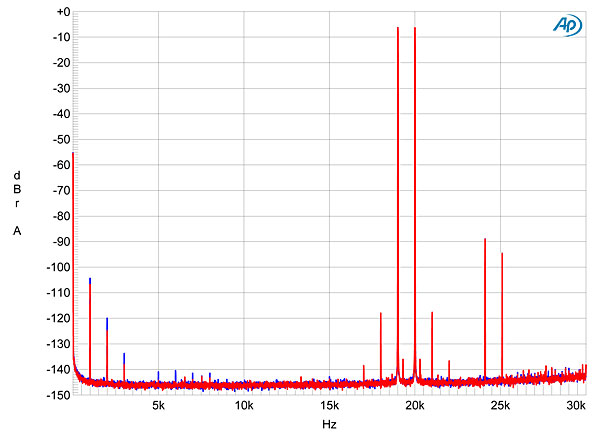
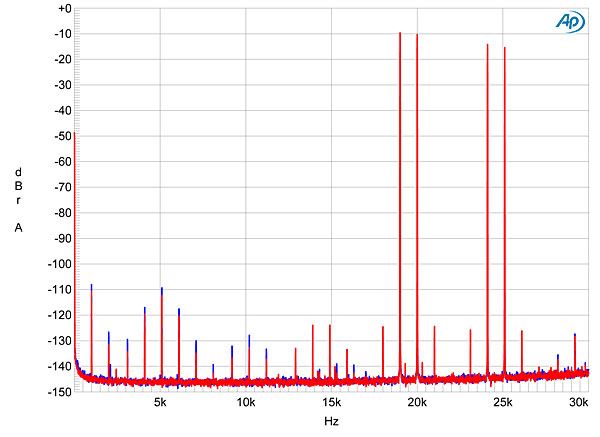
Finally, the T+A DAC 8 DSD offered superb rejection of word-clock jitter via its PCM inputs. Fig.20 was taken with TosLink-sourced 16-bit J-Test data: no spurious sidebands can be seen, and the odd-order harmonics of the low-frequency, LSB-level squarewave are all at the correct level, as shown by the green overlay.
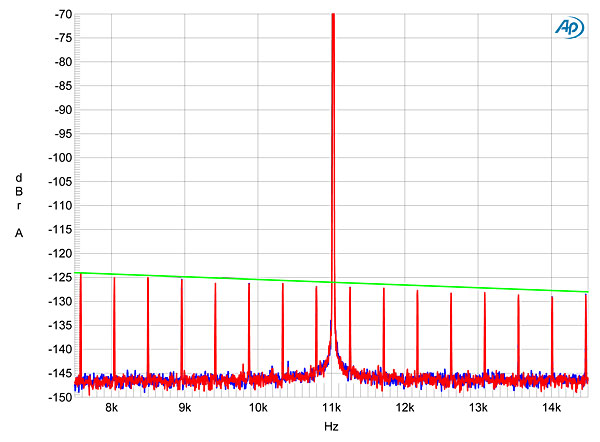
Measuring the T+A DAC 8 DSD, I was reminded of something David Rich, erstwhile reviewer for The Audio Critic, wrote at the beginning of this century: "Eventually all we'll be doing is writing about the sounds of digital filters." With the DAC 8 DSD's measured behavior and sound quality so dependent on which of its four digital filters is in use, it's difficult to make any absolute value judgment. But I'm not surprised that JI liked the sound of the Bez1 filter, which seems to give the best balance between its measured parameters.—John Atkinson
Footnote 2: My thanks to Jürgen Reis, of MBL, for suggesting this test to me.

Can anyone say when this unit does PCM (redbook) is it using DS (1bit) type or Multibit converter, as that looks to be over looked in the review.
Cheers George

Double-Differential-Quadruple-Converter with 4 D/A-Converters per channel, 32-Bit Sigma Delta, 352,8 kSps/384 kSps. Eight times oversampling.

Gross for PCM replay conversion.
From what the gurus in the industries say only Multibit can do PCM without making a facsimile of it.
Cheers George

Thats probably the most accurate thing anyone could say or has said about good quality Consumer DACs! Maybe you should be awarded the "King's new Suit" Award.
I admire your bravery
Tony in Michigan
ps. I've heard it said that if a DAC is doing it's job properly you can't hear it.

I own two old DACs (more than 10 years age) purchased used at less than 80 per cent of their retail price, and really it's hard to tell differences, even subtle ones. First is a one bit, other oversamples at 96, compared to newcomers well you know what's the answer is...

reminds me of when in the 80's people would say all turntables are the same. Digital transport solutions will make DAC's sound alike if they aren't up to snuff.

... for the most thoughtful and well considered DAC review I've ever read. It's an interesting comment that as the technology matures, digital filters will become more significant than other design factors.

Disagree with this. Realize that the comment is about the Ayre Codex vs. a DAC a few years old. The difference is primarily the filters. Yet sounds "damn close". If that's the difference filters make (especially something so significantly different like the Codex/PonoPlayer), then it's not unreasonable to say that filters are not all that different sounding, right?

I see things like, "DSD64 appears on the display as either "2M8 DSD" or "3M1 DSD" (2.8MHz or 3.1MHz), depending on whether the base clock is 44.1 or 48kHz; DSD128 is displayed as "5M6 DSD" or "6M1 DSD"; and so on, all the way up to "22M6 DSD" or "24M6 DSD," for DSD512," or "four S/PDIF (RCA), BNC, optical, AES/EBU, and USB. The USB input accepts PCM up to 32-bit/384kHz and DSD up to DSD512; DSD256 and DSD512 are possible only with USB streams from Windows operating systems..." and my brain just goes all dial tone.
I figured out Tidal into my Explorer DAC to the real Hi Fi and that was a major accomplishment!
;-D
If it ever gets idiot-level easy, I will hit the button!

It just sounds like the DSD naming scheme is unnecessarily pretentious in trying to sound *different* instead of sticking with convention and what most would recognize.
It's rather ridiculous, as if there's something special about those labels. Likewise, all those acronyms that companies tend to use for techniques that are essentially just variants of well-known algorithms/technologies end up falling flat as well...

"CAminion :reminds me of when in the 80's people would say all turntables are the same. Digital transport solutions will make DAC's sound alike if they aren't up to snuff."

As a T+A dealer, with one of the largest collections of dacs on the East Coast, I am very puzzled by this review! I have been in professional audio retailing for 27 years or since the beginning of the digital revolution, and I can say unequivocally that I am at odds with this review.
To say that two digital front ends sound alike is saying that two sports cars drive the same, sure they are both fast, but the feeling of say a BMW vs a Mercedes is totally different.
If you look at two different dacs unless they are using the same decoding chips and on board filters, then the only difference might be the analog stage, I find there is generally a world of sonic difference between two dacs with carefully level matching.
Take an Auralic Vega vs an NAD M51 these are totally different animals, with completely different technologies, and yes they both sound very good the more expensive dac does sound better, with a wider and more defined sound stage, and greater resolution.
To lump the T+A in with some of these other dacs is doing the T+A dac a disservice. The writer said he did not play with up sampling redbook to Quad Rate DSD, when on all the forums that are talking about this dac are saying that you must hear it at that frequency and decoding type.
I ran J River and took a 16 bit 44k CD and through J River spit out a Dual rate than Quad Rate DSD file on the fly for the T+A DAD 8 DSD to decode, and the difference between the two sampling rates was very audible, Dual DSD was good, Quad rate DSD was amazing!
Many people reading the review might think that the DSD decoding engine can only be used with DSD files when you can easily convert PCS to DSD and vice versa.
The DAC 8 DSD sound great on PCM but feed it a Quad Rate DSD track and you will be absolutely floored, and it moves this little $4k dac into the big leagues, I would say under $10k the Dac 8 is very hard to beat, there is an organic sound and a spooky real sense of presence that once you hear it you will be shocked at just how special the DAC 8 is.

If you really want to hear something special then feed this DAC any music file up-sampled to DSD512 using HQ Player software and with Roon as the manager.
It is sad when the professional reviewer barely scratches the surface of what a piece of equipment can do.
But then the professional dealer also misses the mark on the best part.
Thank goodness for the audio forums.
PS How would I know. Because I am one of the ones using it as such. And I have a huge smile from the enjoyment.